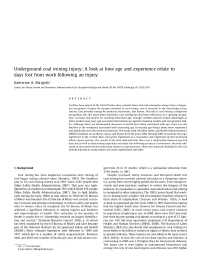Mining Publication: Underground Coal Mining Injury: A Look at How Age and Experience Relate to Days Lost from Work Following an Injury
Original creation date: April 2010
Coal has been mined in the United States since colonial times and coal mining has always been a dangerous occupation. Despite the dangers involved in coal mining, coal is essential to the functioning of our society. Coal provides energy for products, businesses, and homes. Not only is coal mining a dangerous occupation, but, like many other industries, coal mining has also been referred to as a "graying occupation" as many coal miners are reaching retirement age. Younger workers possess certain advantages as older workers may have age-associated decrements in cognitive function, health, and recuperative ability. Although there are documented decreases in health and safety associated with age, there are also benefits at the workplace associated with increasing age. Increasing age brings about more experience and familiarity with the work environment. This study used the Mine Safety and Health Administration's (MSHA) database on accidents, injury, and illness from the years 2003 through 2007 to examine how age, experience at the current mine, total years experience as a coal miner, and experience in the current job affects injury severity. The results of the data indicated that there was a relationship between age and days lost as well as total mining experience and days lost following an injury. Furthermore, the data indicated an increased risk of overexertion injuries as age increases. These are important findings for the coal mining industry as many miners are more experienced and older.
Authors: KA Margolis
See Also
- Escape From Farmington No. 9: An Oral History
- Overview of U.S. Research on Three Approaches to Ensuring That Coal Miners Work Safely: Management, Workplace Design and Training
- Refuge Alternatives in Underground Coal Mines
- Research Report on Refuge Alternatives for Underground Coal Mines
- Safe and Economical Inerting of Sealed Mine Areas
- Solutions to Prevent Materials-Handling Injuries in Underground Coal Mines
- Technology for Remote Mine Seal Construction
- Technology News 535 - NIOSH Releases New Educational Video: Escape from Farmington No. 9: An Oral History
- Ultra-Low Frequency Through-the-Earth Communication Technology
- Wireless Mesh Mine Communication System
- Content source: National Institute for Occupational Safety and Health, Mining Program


 ShareCompartir
ShareCompartir
